weight MERCEDES-BENZ SLS AMG COUPE 2014 Owners Manual
[x] Cancel search | Manufacturer: MERCEDES-BENZ, Model Year: 2014, Model line: SLS AMG COUPE, Model: MERCEDES-BENZ SLS AMG COUPE 2014Pages: 292, PDF Size: 37.82 MB
Page 8 of 292
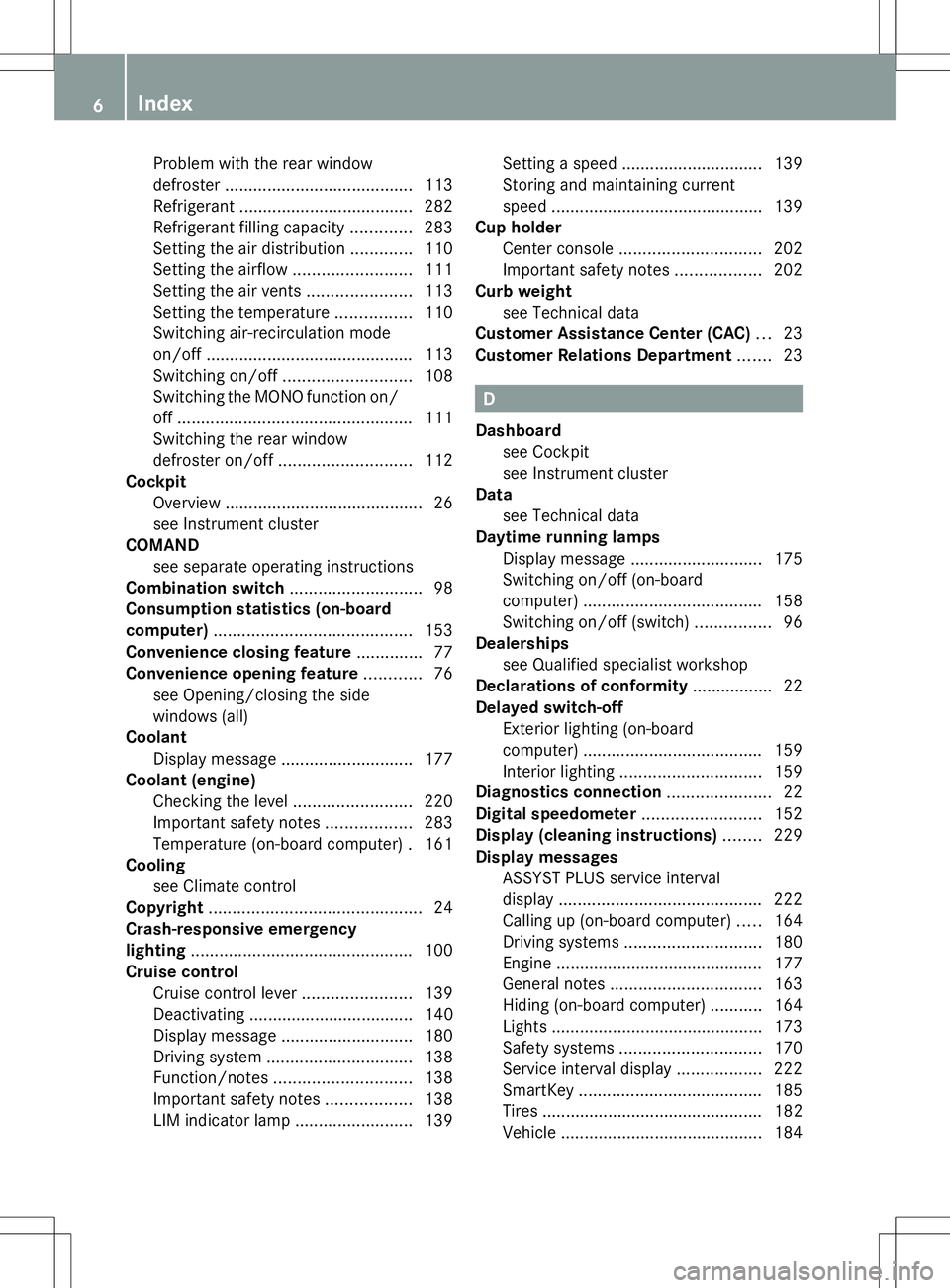
Problem with the rear window
defroster
........................................ 113
Refrigerant ..................................... 282
Refrigerant filling capacity .............283
Setting the air distribution .............110
Setting the airflow .........................111
Setting the air vents ......................113
Setting the temperature ................110
Switching air-recirculation mode
on/off ............................................ 113
Switching on/off ........................... 108
Switching the MONO function on/
off .................................................. 111
Switching the rear window
defroster on/off ............................ 112
Cockpit
Overview .......................................... 26
see Instrument cluster
COMAND
see separate operating instructions
Combination switch ............................98
Consumption statistics (on-board
computer) .......................................... 153
Convenience closing feature ..............77
Convenience opening feature ............76
see Opening/closing the side
windows (all)
Coolant
Display message ............................ 177
Coolant (engine)
Checking the level .........................220
Important safety notes ..................283
Temperature (on-board computer) .161
Cooling
see Climate control
Copyright ............................................. 24
Crash-responsive emergency
lighting ............................................... 100
Cruise control Cruise control lever .......................139
Deactivating ................................... 140
Display message ............................ 180
Driving system ............................... 138
Function/notes ............................. 138
Important safety notes ..................138
LIM indicator lamp .........................139Setting a speed
.............................. 139
Storing and maintaining current
speed ............................................ .139
Cup holder
Center console .............................. 202
Important safety notes ..................202
Curb weight
see Technical data
Customer Assistance Center (CAC) ...23
Customer Relations Department .......23 D
Dashboard see Cockpit
see Instrument cluster
Data
see Technical data
Daytime running lamps
Display message ............................ 175
Switching on/off (on-board
computer) ...................................... 158
Switching on/off (switch) ................96
Dealerships
see Qualified specialist workshop
Declarations of conformity ................. 22
Delayed switch-off Exterior lighting (on-board
computer) ...................................... 159
Interior lighting .............................. 159
Diagnostics connection ......................22
Digital speedometer .........................152
Display (cleaning instructions) ........229
Display messages ASSYST PLUS service interval
displa y........................................... 222
Calling up (on-board computer) .....164
Driving systems ............................. 180
Engine ............................................ 177
General notes ................................ 163
Hiding (on-board computer) ...........164
Lights ............................................ .173
Safety systems .............................. 170
Service interval displa y.................. 222
SmartKey ....................................... 185
Tires ............................................... 182
Vehicle .......................................... .184 6
Index
Page 16 of 292
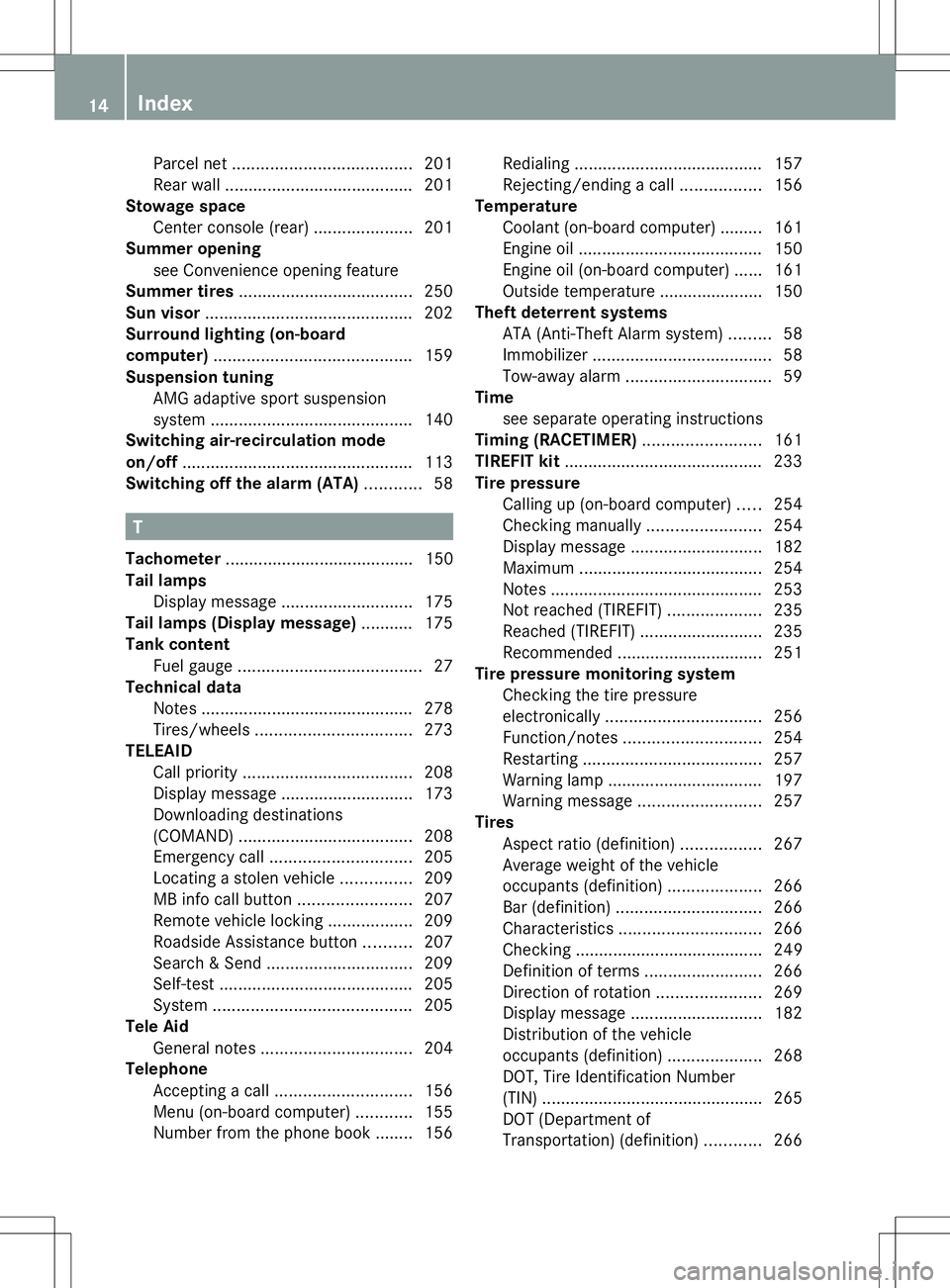
Parcel net
...................................... 201
Rear wall ........................................ 201
Stowage space
Center console (rear) .....................201
Summer opening
see Convenience opening feature
Summer tires ..................................... 250
Sun visor ............................................ 202
Surround lighting (on-board
computer) .......................................... 159
Suspension tuning AMG adaptive sport suspension
system ........................................... 140
Switching air-recirculation mode
on/off ................................................. 113
Switching off the alarm (ATA) ............58 T
Tachometer ........................................ 150
Tail lamps Display message ............................ 175
Tail lamps (Display message) ........... 175
Tank content Fuel gauge ....................................... 27
Technical data
Notes ............................................. 278
Tires/wheels ................................. 273
TELEAID
Call priority .................................... 208
Display message ............................ 173
Downloading destinations
(COMAND) ..................................... 208
Emergency call .............................. 205
Locating a stolen vehicle ...............209
MB info call button ........................207
Remote vehicle locking ..................209
Roadside Assistance button ..........207
Search & Send ............................... 209
Self-test ......................................... 205
System .......................................... 205
Tele Aid
General notes ................................ 204
Telephone
Accepting a call ............................. 156
Menu (on-board computer) ............155
Number from the phone book ....... .156 Redialing
........................................ 157
Rejecting/ending a call .................156
Temperature
Coolant (on-board computer) ......... 161
Engine oil ....................................... 150
Engine oil (on-board computer) ...... 161
Outside temperature ..................... .150
Theft deterrent systems
ATA (Anti-Theft Alarm system) .........58
Immobilizer ...................................... 58
Tow-away alarm ............................... 59
Time
see separate operating instructions
Timing (RACETIMER) .........................161
TIREFIT kit .......................................... 233
Tire pressure Calling up (on-board computer) .....254
Checking manually ........................254
Display message ............................ 182
Maximum ....................................... 254
Notes ............................................. 253
Not reached (TIREFIT) ....................235
Reached (TIREFIT) ..........................235
Recommended ............................... 251
Tire pressure monitoring system
Checking the tire pressure
electronically ................................. 256
Function/notes ............................. 254
Restarting ...................................... 257
Warning lamp ................................. 197
Warning message .......................... 257
Tires
Aspect ratio (definition) .................267
Average weight of the vehicle
occupants (definition) ....................266
Bar (definition) ............................... 266
Characteristics .............................. 266
Checking ........................................ 249
Definition of terms .........................266
Direction of rotatio n...................... 269
Display message ............................ 182
Distribution of the vehicle
occupants (definition) ....................268
DOT, Tire Identification Number
(TIN) .............................................. .265
DOT (Department of
Transportation) (definition) ............266 14
Index
Page 17 of 292
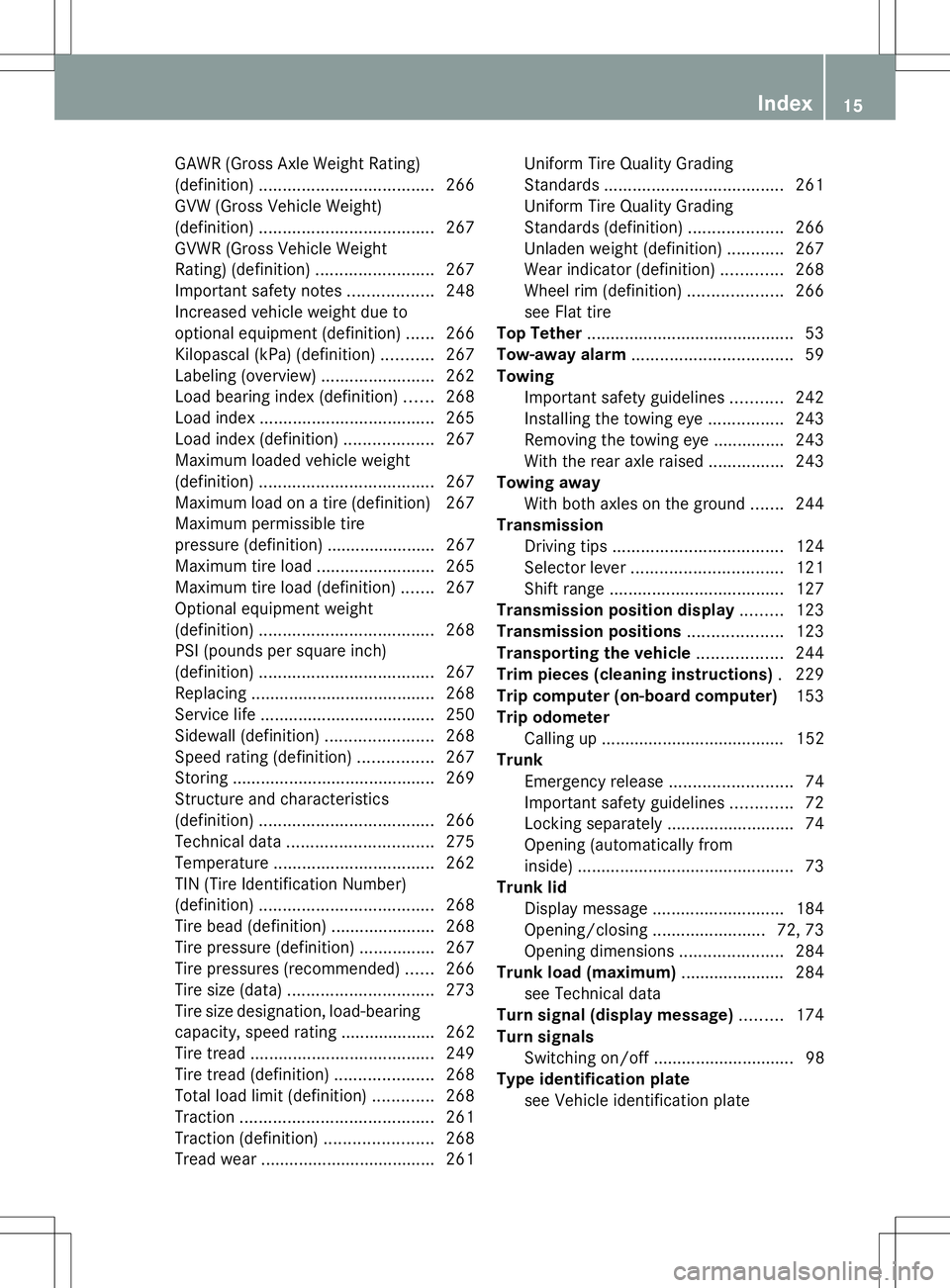
GAWR (Gross Axle Weight Rating)
(definition)
..................................... 266
GVW (Gross Vehicle Weight)
(definition) ..................................... 267
GVWR (Gross Vehicle Weight
Rating) (definition) .........................267
Important safety notes ..................248
Increased vehicle weight due to
optional equipment (definition) ......266
Kilopascal (kPa) (definition) ...........267
Labeling (overview )........................ 262
Load bearing index (definition) ......268
Load index ..................................... 265
Load index (definition) ...................267
Maximum loaded vehicle weight
(definition) ..................................... 267
Maximum load on a tire (definition) 267
Maximum permissible tire
pressure (definition) ....................... 267
Maximum tire loa d......................... 265
Maximum tire load (definition) .......267
Optional equipment weight
(definition) ..................................... 268
PSI (pounds per square inch)
(definition) ..................................... 267
Replacing ....................................... 268
Service life ..................................... 250
Sidewall (definition) .......................268
Speed rating (definition) ................267
Storing ........................................... 269
Structure and characteristics
(definition) ..................................... 266
Technical data ............................... 275
Temperature .................................. 262
TIN (Tire Identification Number)
(definition) ..................................... 268
Tire bead (definition) ......................268
Tire pressure (definition) ................267
Tire pressures (recommended )...... 266
Tire size (data) ............................... 273
Tire size designation, load-bearing
capacity, speed rating .................... 262
Tire tread ....................................... 249
Tire tread (definition) .....................268
Total load limit (definition) .............268
Traction ......................................... 261
Traction (definition) .......................268
Tread wea r..................................... 261Uniform Tire Quality Grading
Standards
...................................... 261
Uniform Tire Quality Grading
Standards (definition) ....................266
Unladen weight (definition) ............267
Wear indicator (definition) .............268
Wheel rim (definition) ....................266
see Flat tire
Top Tether ............................................ 53
Tow-away alarm .................................. 59
Towing Important safety guidelines ...........242
Installing the towing eye ................243
Removing the towing eye ...............243
With the rear axle raised ................243
Towing away
With both axles on the ground .......244
Transmission
Driving tips .................................... 124
Selector lever ................................ 121
Shift range ..................................... 127
Transmission position display .........123
Transmission positions ....................123
Transporting the vehicle ..................244
Trim pieces (cleaning instructions) .229
Trip computer (on-board computer) 153
Trip odometer Calling up ....................................... 152
Trunk
Emergency release ..........................74
Important safety guidelines .............72
Locking separately ...........................74
Opening (automatically from
inside) .............................................. 73
Trunk lid
Display message ............................ 184
Opening/closing ........................72, 73
Opening dimensions ......................284
Trunk load (maximum) ......................284
see Technical data
Turn signal (display message) .........174
Turn signals Switching on/off .............................. 98
Type identification plate
see Vehicle identification plate Index
15
Page 18 of 292
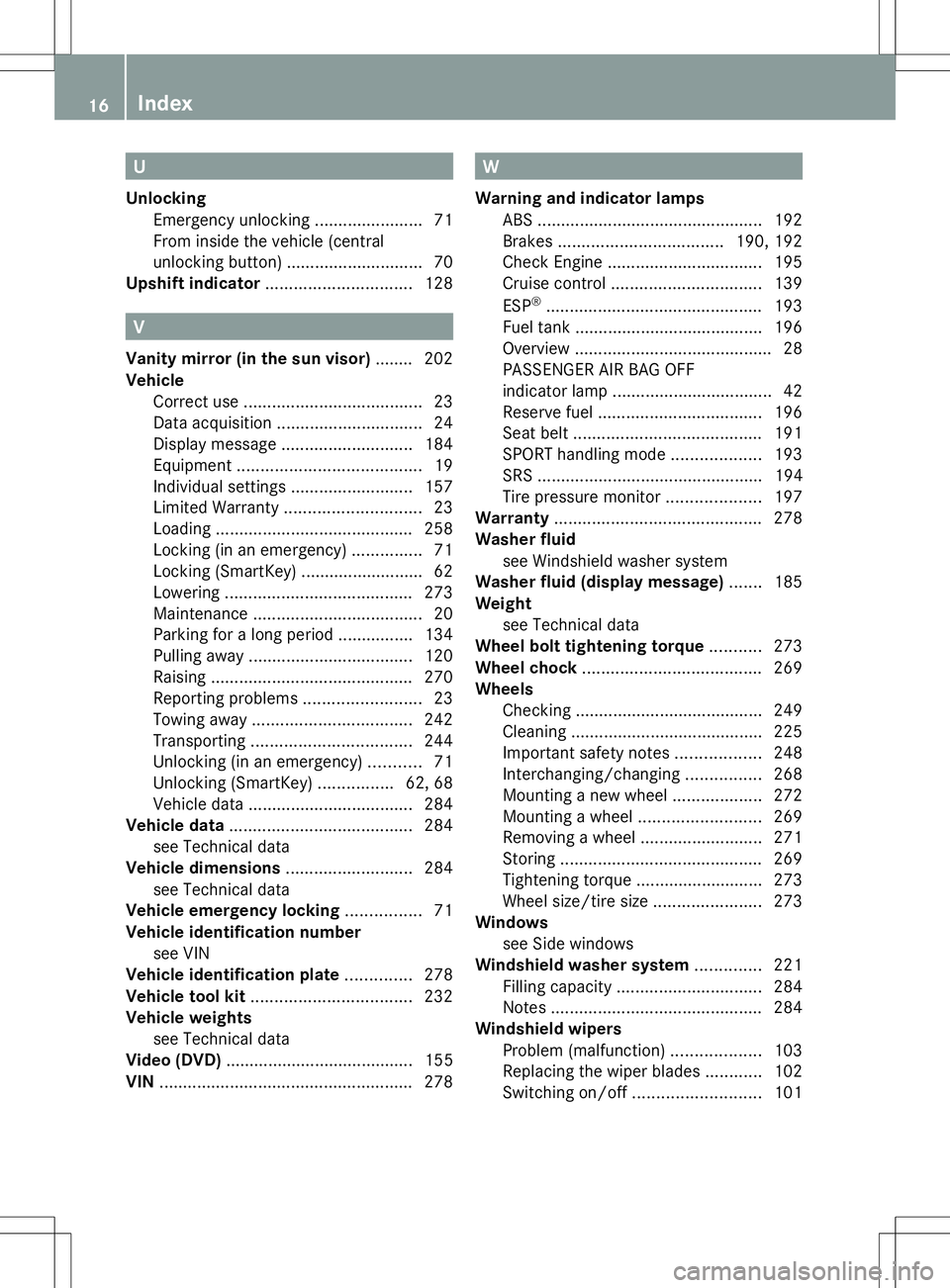
U
Unlocking Emergency unlocking .......................71
From inside the vehicle (central
unlocking button) ............................. 70
Upshift indicator ............................... 128V
Vanity mirror (in the sun visor) ........202
Vehicle Correct use ...................................... 23
Data acquisition ............................... 24
Display message ............................ 184
Equipment ....................................... 19
Individual settings ..........................157
Limited Warranty ............................. 23
Loading .......................................... 258
Locking (in an emergency) ...............71
Locking (SmartKey) .......................... 62
Lowering ........................................ 273
Maintenance .................................... 20
Parking for a long period ................ 134
Pulling away ................................... 120
Raising ........................................... 270
Reporting problems .........................23
Towing away .................................. 242
Transporting .................................. 244
Unlocking (in an emergency) ...........71
Unlocking (SmartKey) ................62, 68
Vehicle data ................................... 284
Vehicle data ....................................... 284
see Technical data
Vehicle dimensions ...........................284
see Technical data
Vehicle emergency locking ................71
Vehicle identification number see VIN
Vehicle identification plate ..............278
Vehicle tool kit .................................. 232
Vehicle weights see Technical data
Video (DVD) ........................................ 155
VIN ...................................................... 278 W
Warning and indicator lamps ABS ................................................ 192
Brakes ................................... 190, 192
Check Engine ................................. 195
Cruise control ................................ 139
ESP ®
.............................................. 193
Fuel tank ........................................ 196
Overview .......................................... 28
PASSENGER AIR BAG OFF
indicator lamp .................................. 42
Reserve fuel ................................... 196
Seat belt ........................................ 191
SPORT handling mode ...................193
SRS ................................................ 194
Tire pressure monitor ....................197
Warranty ............................................ 278
Washer fluid see Windshield washer system
Washer fluid (display message) .......185
Weight see Technical data
Wheel bolt tightening torque ...........273
Wheel chock ...................................... 269
Wheels Checking ........................................ 249
Cleaning ......................................... 225
Important safety notes ..................248
Interchanging/changing ................268
Mounting a new wheel ...................272
Mounting a wheel .......................... 269
Removing a wheel ..........................271
Storing ........................................... 269
Tightening torque ........................... 273
Wheel size/tire size .......................273
Windows
see Side windows
Windshield washer system ..............221
Filling capacity ............................... 284
Notes ............................................. 284
Windshield wipers
Problem (malfunction) ...................103
Replacing the wiper blades ............102
Switching on/off ........................... 10116
Index
Page 20 of 292
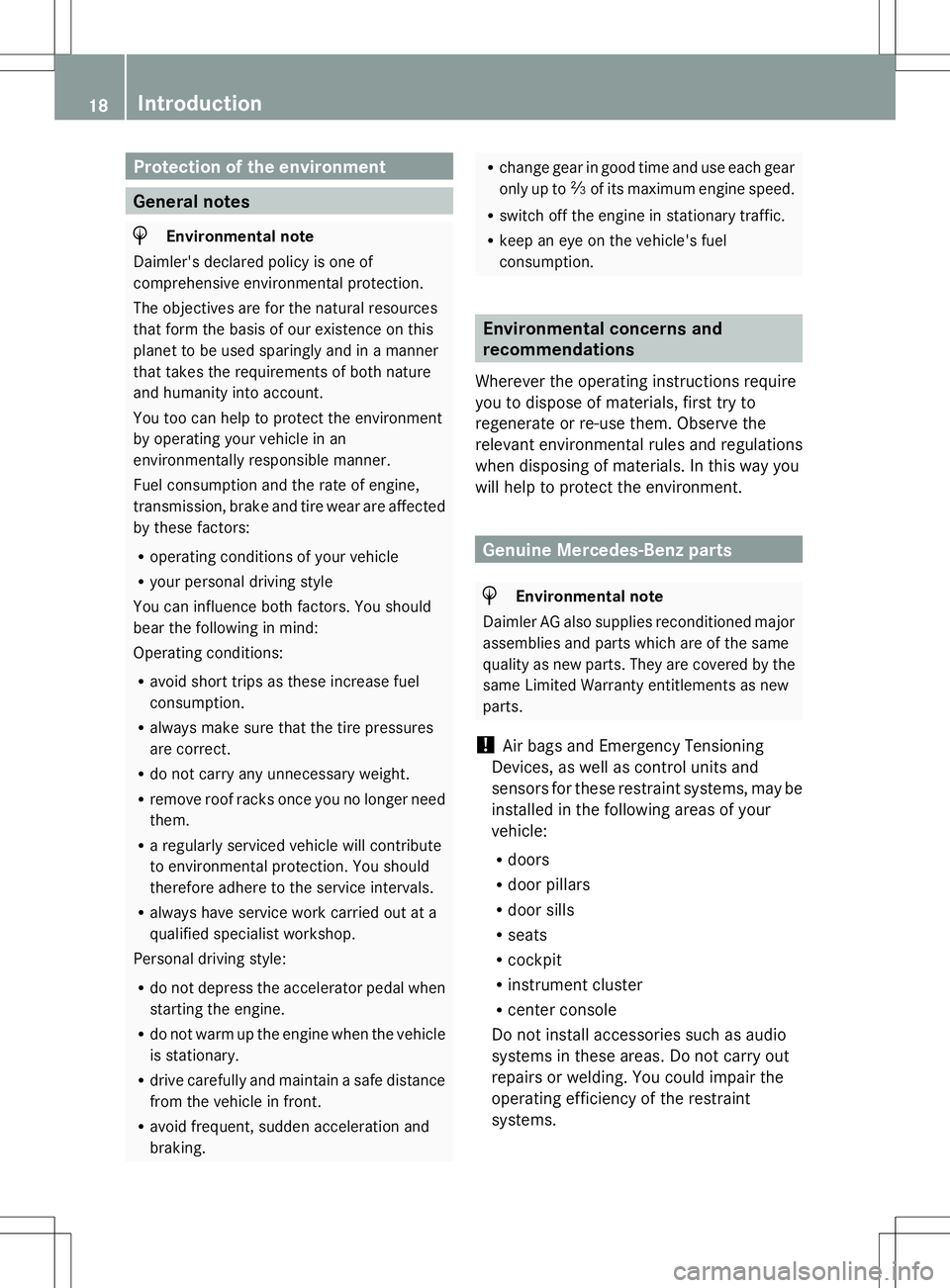
Protection of the environment
General notes
H
Environmental note
Daimler's declared policy is one of
comprehensive environmental protection.
The objectives are for the natural resources
that form the basis of our existence on this
planet to be used sparingly and in a manner
that takes the requirements of both nature
and humanity into account.
You too can help to protect the environment
by operating your vehicle in an
environmentally responsible manner.
Fuel consumption and the rate of engine,
transmission, brake and tire wear are affected
by these factors:
R operating conditions of your vehicle
R your personal driving style
You can influence both factors. You should
bear the following in mind:
Operating conditions:
R avoid short trips as these increase fuel
consumption.
R always make sure that the tire pressures
are correct.
R do not carry any unnecessary weight.
R remove roof racks once you no longer need
them.
R a regularly serviced vehicle will contribute
to environmental protection. You should
therefore adhere to the service intervals.
R always have service work carried out at a
qualified specialist workshop.
Personal driving style:
R do not depress the accelerator pedal when
starting the engine.
R do not warm up the engine when the vehicle
is stationary.
R drive carefully and maintain a safe distance
from the vehicle in front.
R avoid frequent, sudden acceleration and
braking. R
change gear in good time and use each gear
only up to Ôof its maximum engine speed.
R switch off the engine in stationary traffic.
R keep an eye on the vehicle's fuel
consumption. Environmental concerns and
recommendations
Wherever the operating instructions require
you to dispose of materials, first try to
regenerate or re-use them. Observe the
relevant environmental rules and regulations
when disposing of materials. In this way you
will help to protect the environment. Genuine Mercedes-Benz parts
H
Environmental note
Daimler AG also supplies reconditioned major
assemblies and parts which are of the same
quality as new parts. They are covered by the
same Limited Warranty entitlements as new
parts.
! Air bags and Emergency Tensioning
Devices, as well as control units and
sensors for these restraint systems, may be
installed in the following areas of your
vehicle:
R doors
R door pillars
R door sills
R seats
R cockpit
R instrument cluster
R center console
Do not install accessories such as audio
systems in these areas. Do not carry out
repairs or welding. You could impair the
operating efficiency of the restraint
systems. 18
Introduction
Page 41 of 292
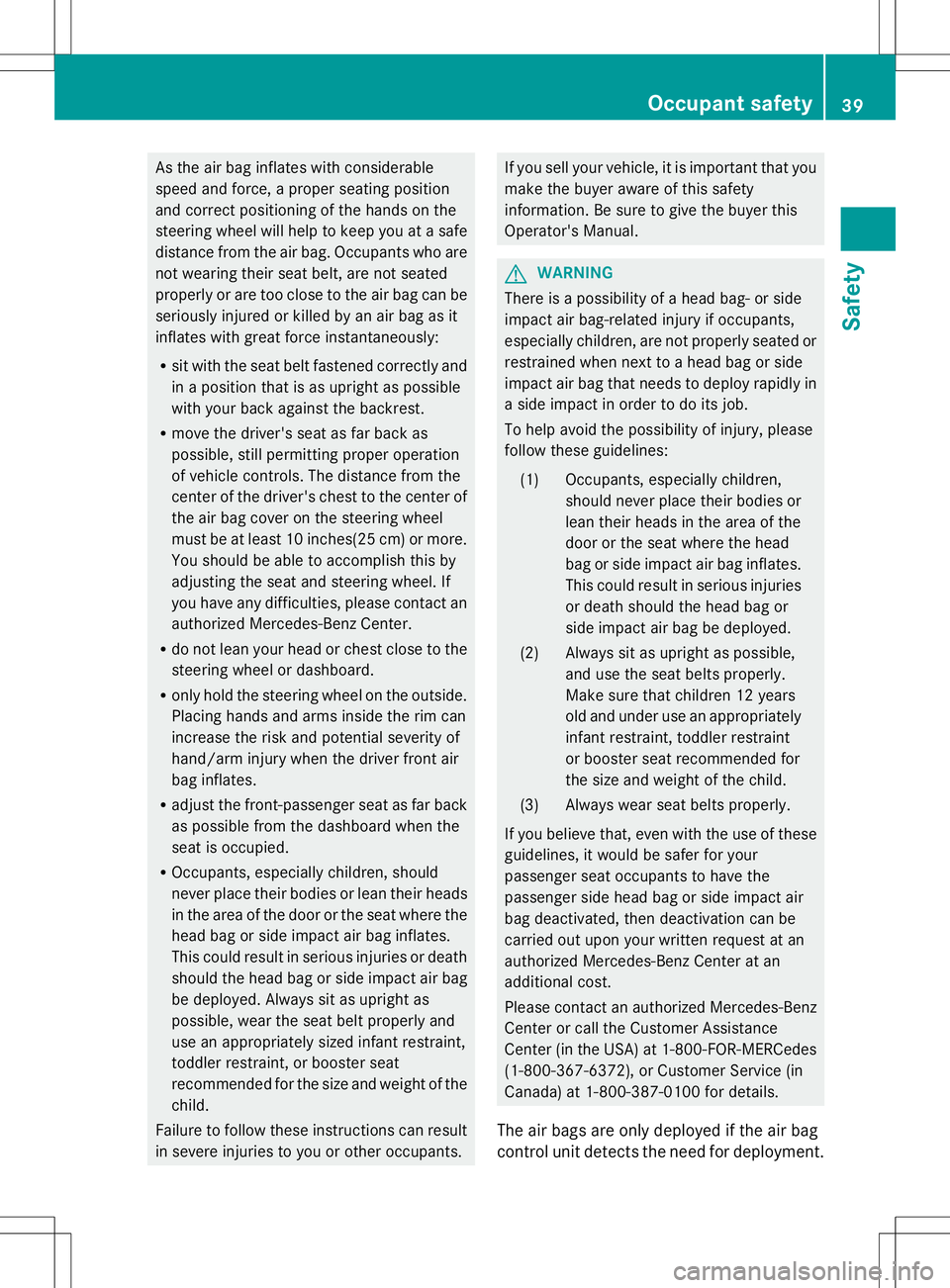
As the air bag inflates with considerable
speed and force, a proper seating position
and correct positioning of the hands on the
steering wheel will help to keep you at a safe
distance from the air bag. Occupants who are
not wearing their seat belt, are not seated
properly or are too close to the air bag can be
seriously injured or killed by an air bag as it
inflates with great force instantaneously:
R sit with the seat belt fastened correctly and
in a position that is as upright as possible
with your back against the backrest.
R move the driver's seat as far back as
possible, still permitting proper operation
of vehicle controls. The distance from the
center of the driver's chest to the center of
the air bag cover on the steering wheel
must be at least 10 inches(25 cm) or more.
You should be able to accomplish this by
adjusting the seat and steering wheel. If
you have any difficulties, please contact an
authorized Mercedes-Benz Center.
R do not lean your head or chest close to the
steering wheel or dashboard.
R only hold the steering wheel on the outside.
Placing hands and arms inside the rim can
increase the risk and potential severity of
hand/arm injury when the driver front air
bag inflates.
R adjust the front-passenger seat as far back
as possible from the dashboard when the
seat is occupied.
R Occupants, especially children, should
never place their bodies or lean their heads
in the area of the door or the seat where the
head bag or side impact air bag inflates.
This could result in serious injuries or death
should the head bag or side impact air bag
be deployed. Always sit as upright as
possible, wear the seat belt properly and
use an appropriately sized infant restraint,
toddler restraint, or booster seat
recommended for the size and weight of the
child.
Failure to follow these instructions can result
in severe injuries to you or other occupants. If you sell your vehicle, it is important that you
make the buyer aware of this safety
information. Be sure to give the buyer this
Operator's Manual.
G
WARNING
There is a possibility of a head bag- or side
impact air bag-related injury if occupants,
especially children, are not properly seated or
restrained when next to a head bag or side
impact air bag that needs to deploy rapidly in
a side impact in order to do its job.
To help avoid the possibility of injury, please
follow these guidelines:
(1) Occupants, especially children, should never place their bodies or
lean their heads in the area of the
door or the seat where the head
bag or side impact air bag inflates.
This could result in serious injuries
or death should the head bag or
side impact air bag be deployed.
(2) Always sit as upright as possible, and use the seat belts properly.
Make sure that children 12 years
old and under use an appropriately
infant restraint, toddler restraint
or booster seat recommended for
the size and weight of the child.
(3) Always wear seat belts properly.
If you believe that, even with the use of these
guidelines, it would be safer for your
passenger seat occupants to have the
passenger side head bag or side impact air
bag deactivated, then deactivation can be
carried out upon your written request at an
authorized Mercedes-Benz Center at an
additional cost.
Please contact an authorized Mercedes-Benz
Center or call the Customer Assistance
Center (in the USA) at 1-800-FOR-MERCedes
(1-800-367-6372), or Customer Service (in
Canada) at 1-800-387-0100 for details.
The air bags are only deployed if the air bag
control unit detects the need for deployment. Occupant safety
39Safety Z
Page 42 of 292
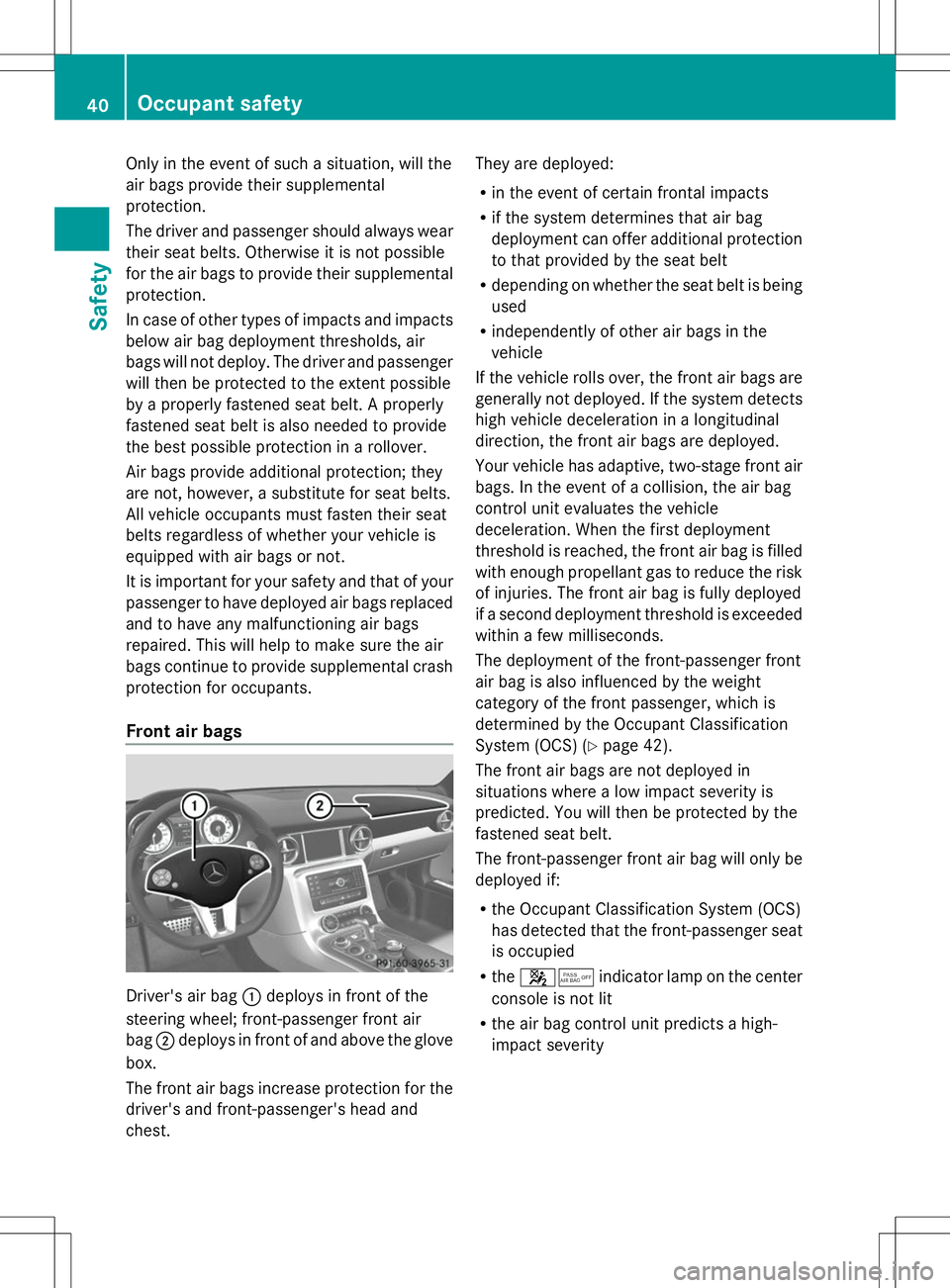
Only in the event of such a situation, will the
air bags provide their supplemental
protection.
The driver and passenger should always wear
their seat belts. Otherwise it is not possible
for the air bags to provide their supplemental
protection.
In case of other types of impacts and impacts
below air bag deployment thresholds, air
bags will not deploy. The driver and passenger
will then be protected to the extent possible
by a properly fastened seat belt. A properly
fastened seat belt is also needed to provide
the best possible protection in a rollover.
Air bags provide additional protection; they
are not, however, a substitute for seat belts.
All vehicle occupants must fasten their seat
belts regardless of whether your vehicle is
equipped with air bags or not.
It is important for your safety and that of your
passenger to have deployed air bags replaced
and to have any malfunctioning air bags
repaired. This will help to make sure the air
bags continue to provide supplemental crash
protection for occupants.
Front air bags Driver's air bag
:deploys in front of the
steering wheel; front-passenger front air
bag ;deploys in front of and above the glove
box.
The front air bags increase protection for the
driver's and front-passenger's head and
chest. They are deployed:
R
in the event of certain frontal impacts
R if the system determines that air bag
deployment can offer additional protection
to that provided by the seat belt
R depending on whether the seat belt is being
used
R independently of other air bags in the
vehicle
If the vehicle rolls over, the front air bags are
generally not deployed. If the system detects
high vehicle deceleration in a longitudinal
direction, the front air bags are deployed.
Your vehicle has adaptive, two-stage front air
bags. In the event of a collision, the air bag
control unit evaluates the vehicle
deceleration. When the first deployment
threshold is reached, the front air bag is filled
with enough propellant gas to reduce the risk
of injuries. The front air bag is fully deployed
if a second deployment threshold is exceeded
within a few milliseconds.
The deployment of the front-passenger front
air bag is also influenced by the weight
category of the front passenger, which is
determined by the Occupant Classification
System (OCS) (Y page 42).
The front air bags are not deployed in
situations where a low impact severity is
predicted. You will then be protected by the
fastened seat belt.
The front-passenger front air bag will only be
deployed if:
R the Occupant Classification System (OCS)
has detected that the front-passenger seat
is occupied
R the 45 indicator lamp on the center
console is not lit
R the air bag control unit predicts a high-
impact severity 40
Occupant safetySafety
Page 44 of 292
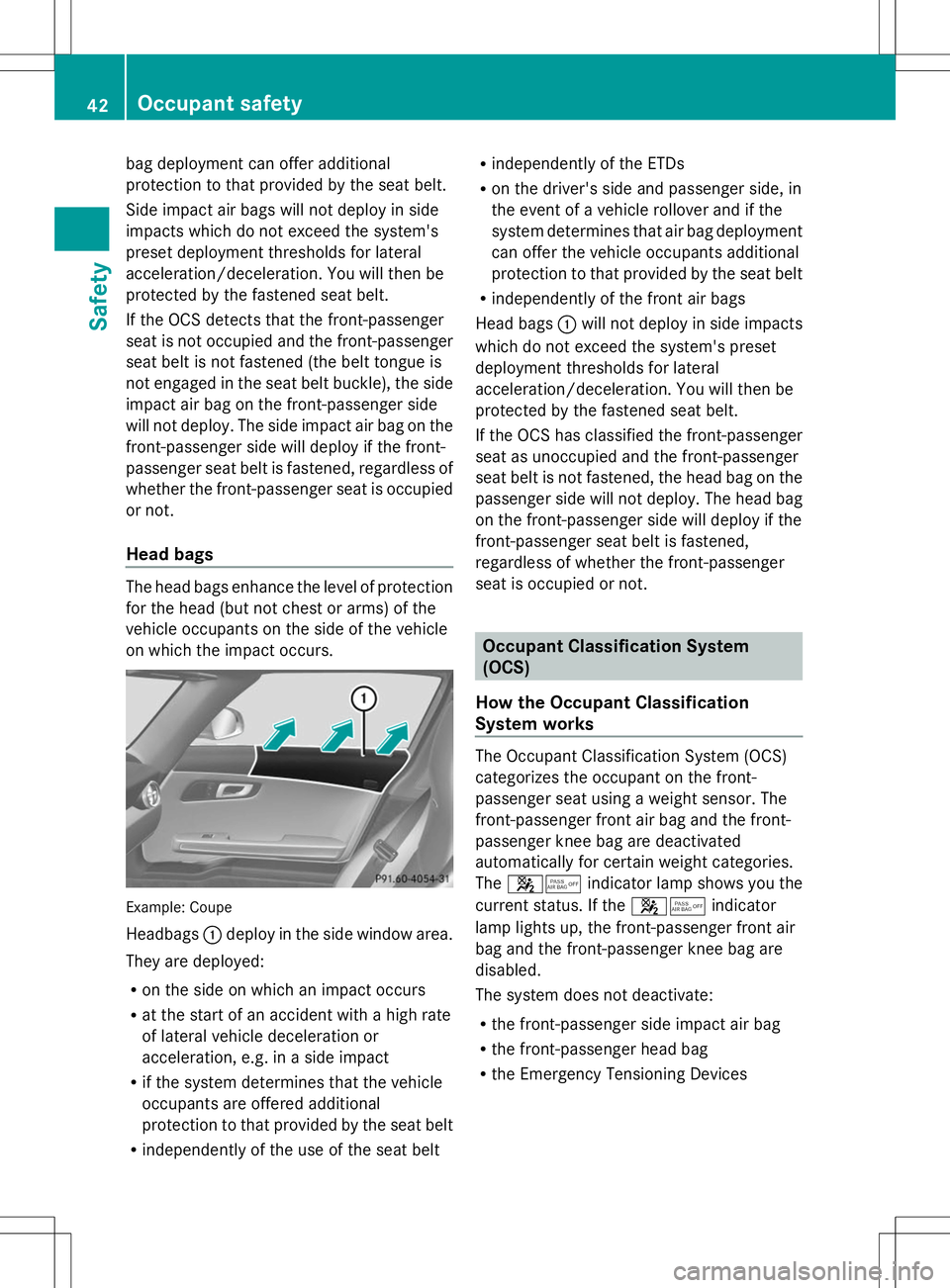
bag deployment can offer additional
protection to that provided by the seat belt.
Side impact air bags will not deploy in side
impacts which do not exceed the system's
preset deployment thresholds for lateral
acceleration/deceleration. You will then be
protected by the fastened seat belt.
If the OCS detects that the front-passenger
seat is not occupied and the front-passenger
seat belt is not fastened (the belt tongue is
not engaged in the seat belt buckle), the side
impact air bag on the front-passenger side
will not deploy. The side impact air bag on the
front-passenger side will deploy if the front-
passenger seat belt is fastened, regardless of
whether the front-passenger seat is occupied
or not.
Head bags The head bags enhance the level of protection
for the head (but not chest or arms) of the
vehicle occupants on the side of the vehicle
on which the impact occurs. Example: Coupe
Headbags
:deploy in the side window area.
They are deployed:
R on the side on which an impact occurs
R at the start of an accident with a high rate
of lateral vehicle deceleration or
acceleration, e.g. in a side impact
R if the system determines that the vehicle
occupants are offered additional
protection to that provided by the seat belt
R independently of the use of the seat belt R
independently of the ETDs
R on the driver's side and passenger side, in
the event of a vehicle rollover and if the
system determines that air bag deployment
can offer the vehicle occupants additional
protection to that provided by the seat belt
R independently of the front air bags
Head bags :will not deploy in side impacts
which do not exceed the system's preset
deployment thresholds for lateral
acceleration/deceleration. You will then be
protected by the fastened seat belt.
If the OCS has classified the front-passenger
seat as unoccupied and the front-passenger
seat belt is not fastened, the head bag on the
passenger side will not deploy. The head bag
on the front-passenger side will deploy if the
front-passenger seat belt is fastened,
regardless of whether the front-passenger
seat is occupied or not. Occupant Classification System
(OCS)
How the Occupant Classification
System works The Occupant Classification System (OCS)
categorizes the occupant on the front-
passenger seat using a weight sensor. The
front-passenger front air bag and the front-
passenger knee bag are deactivated
automatically for certain weight categories.
The 45 indicator lamp shows you the
current status. If the 45indicator
lamp lights up, the front-passenger front air
bag and the front-passenger knee bag are
disabled.
The system does not deactivate:
R the front-passenger side impact air bag
R the front-passenger head bag
R the Emergency Tensioning Devices 42
Occupant safetySafety
Page 45 of 292
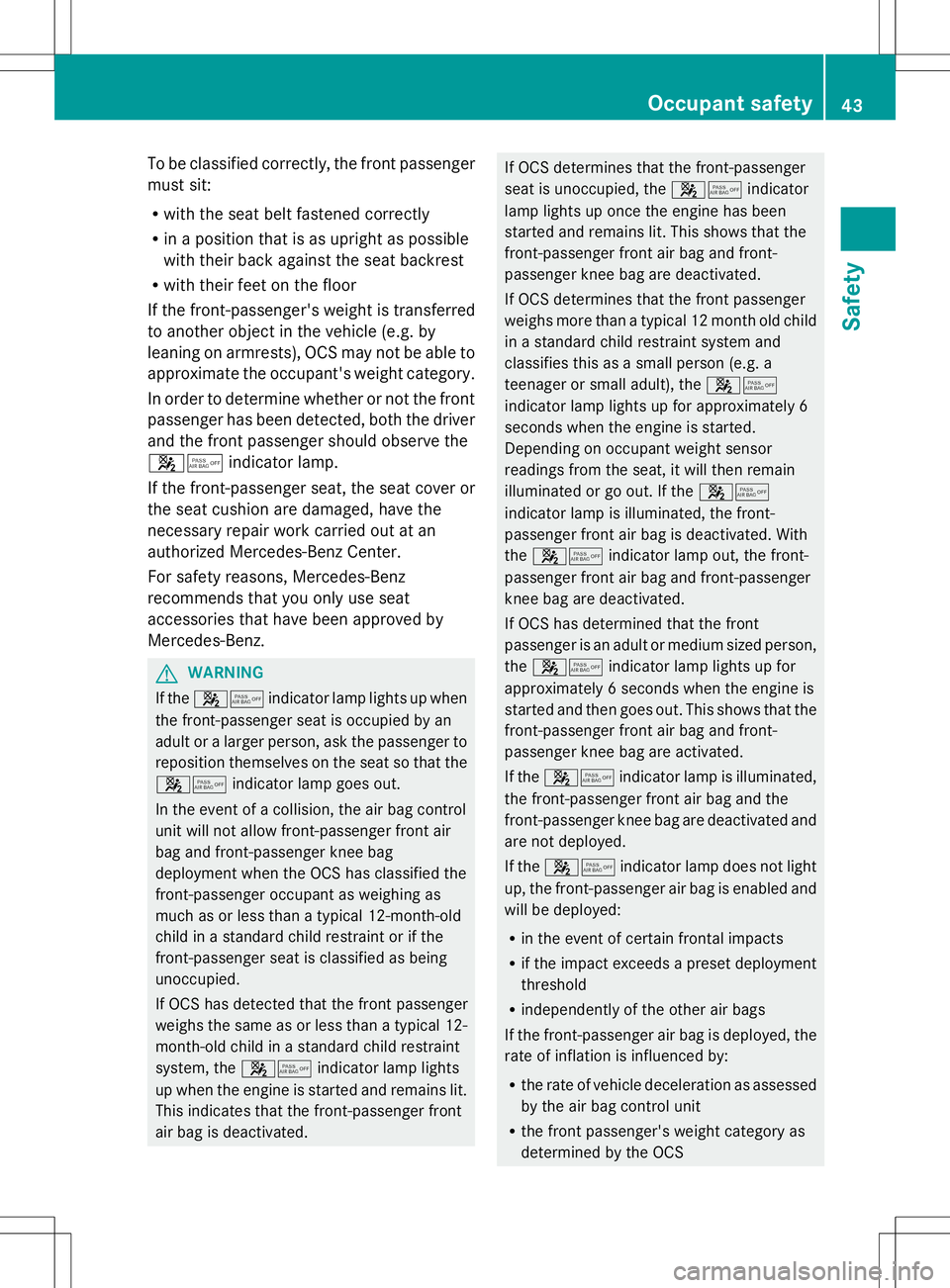
To be classified correctly, the front passenger
must sit:
R with the seat belt fastened correctly
R in a position that is as upright as possible
with their back against the seat backrest
R with their feet on the floor
If the front-passenger's weight is transferred
to another object in the vehicle (e.g. by
leaning on armrests), OCS may not be able to
approximate the occupant's weight category.
In order to determine whether or not the front
passenger has been detected, both the driver
and the front passenger should observe the
45 indicator lamp.
If the front-passenger seat, the seat cover or
the seat cushion are damaged, have the
necessary repair work carried out at an
authorized Mercedes-Benz Center.
For safety reasons, Mercedes-Benz
recommends that you only use seat
accessories that have been approved by
Mercedes-Benz. G
WARNING
If the 45 indicator lamp lights up when
the front-passenger seat is occupied by an
adult or a larger person, ask the passenger to
reposition themselves on the seat so that the
45 indicator lamp goes out.
In the event of a collision, the air bag control
unit will not allow front-passenger front air
bag and front-passenger knee bag
deployment when the OCS has classified the
front-passenger occupant as weighing as
much as or less than a typical 12-month-old
child in a standard child restraint or if the
front-passenger seat is classified as being
unoccupied.
If OCS has detected that the front passenger
weighs the same as or less than a typical 12-
month-old child in a standard child restraint
system, the 45indicator lamp lights
up when the engine is started and remains lit.
This indicates that the front-passenger front
air bag is deactivated. If OCS determines that the front-passenger
seat is unoccupied, the
45indicator
lamp lights up once the engine has been
started and remains lit. This shows that the
front-passenger front air bag and front-
passenger knee bag are deactivated.
If OCS determines that the front passenger
weighs more than a typical 12 month old child
in a standard child restraint system and
classifies this as a small person (e.g. a
teenager or small adult), the 45
indicator lamp lights up for approximately 6
seconds when the engine is started.
Depending on occupant weight sensor
readings from the seat, it will then remain
illuminated or go out. If the 45
indicator lamp is illuminated, the front-
passenger front air bag is deactivated. With
the 45 indicator lamp out, the front-
passenger front air bag and front-passenger
knee bag are deactivated.
If OCS has determined that the front
passenger is an adult or medium sized person,
the 45 indicator lamp lights up for
approximately 6 seconds when the engine is
started and then goes out. This shows that the
front-passenger front air bag and front-
passenger knee bag are activated.
If the 45 indicator lamp is illuminated,
the front-passenger front air bag and the
front-passenger knee bag are deactivated and
are not deployed.
If the 45 indicator lamp does not light
up, the front-passenger air bag is enabled and
will be deployed:
R in the event of certain frontal impacts
R if the impact exceeds a preset deployment
threshold
R independently of the other air bags
If the front-passenger air bag is deployed, the
rate of inflation is influenced by:
R the rate of vehicle deceleration as assessed
by the air bag control unit
R the front passenger's weight category as
determined by the OCS Occupant safety
43Safety Z
Page 46 of 292
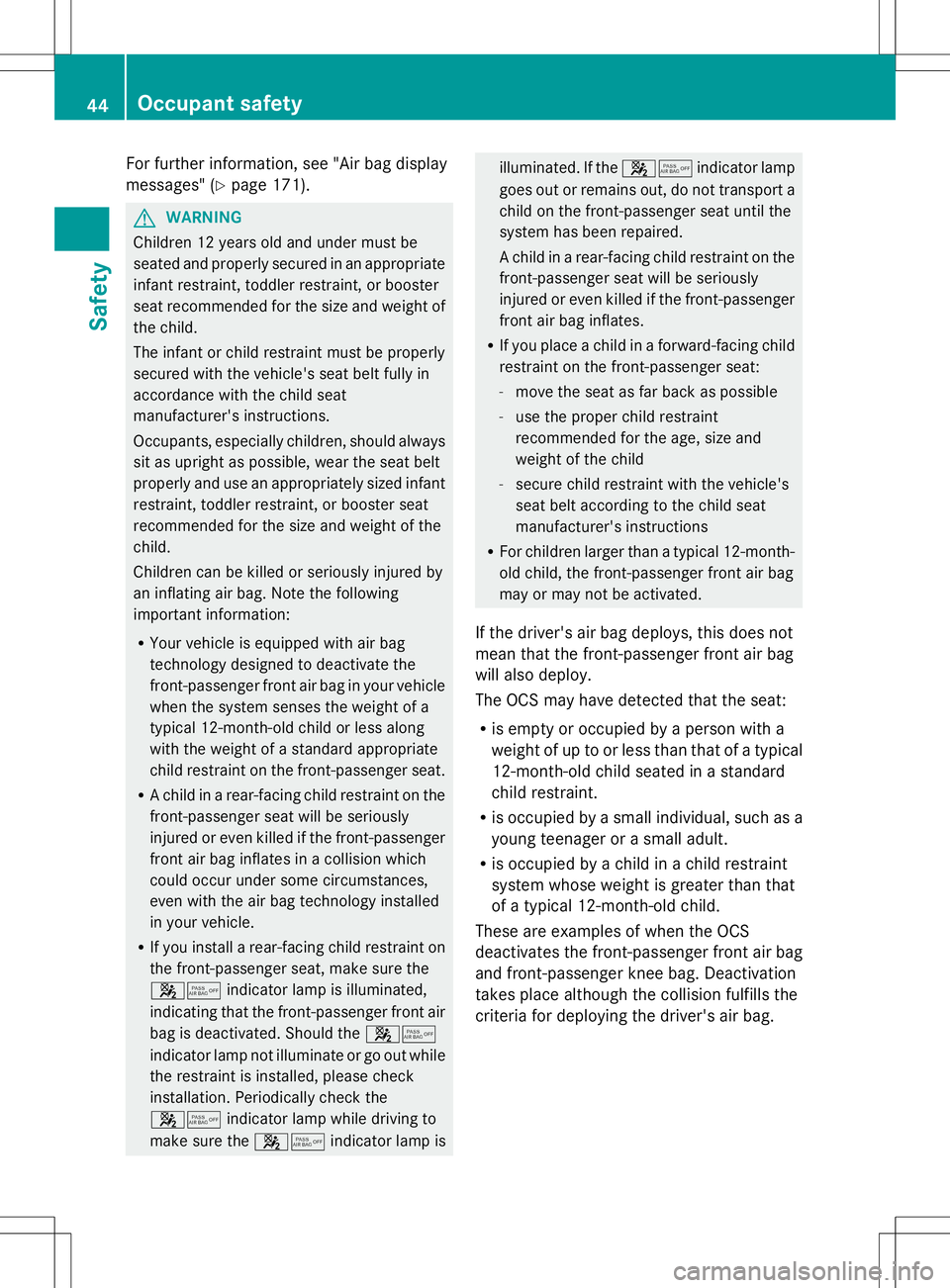
For further information, see "Air bag display
messages" (Y page 171). G
WARNING
Children 12 years old and under must be
seated and properly secured in an appropriate
infant restraint, toddler restraint, or booster
seat recommended for the size and weight of
the child.
The infant or child restraint must be properly
secured with the vehicle's seat belt fully in
accordance with the child seat
manufacturer's instructions.
Occupants, especially children, should always
sit as upright as possible, wear the seat belt
properly and use an appropriately sized infant
restraint, toddler restraint, or booster seat
recommended for the size and weight of the
child.
Children can be killed or seriously injured by
an inflating air bag. Note the following
important information:
R Your vehicle is equipped with air bag
technology designed to deactivate the
front-passenger front air bag in your vehicle
when the system senses the weight of a
typical 12-month-old child or less along
with the weight of a standard appropriate
child restraint on the front-passenger seat.
R A child in a rear-facing child restraint on the
front-passenger seat will be seriously
injured or even killed if the front-passenger
front air bag inflates in a collision which
could occur under some circumstances,
even with the air bag technology installed
in your vehicle.
R If you install a rear-facing child restraint on
the front-passenger seat, make sure the
45 indicator lamp is illuminated,
indicating that the front-passenger front air
bag is deactivated. Should the 45
indicator lamp not illuminate or go out while
the restraint is installed, please check
installation. Periodically check the
45 indicator lamp while driving to
make sure the 45indicator lamp is illuminated. If the
45indicator lamp
goes out or remains out, do not transport a
child on the front-passenger seat until the
system has been repaired.
A child in a rear-facing child restraint on the
front-passenger seat will be seriously
injured or even killed if the front-passenger
front air bag inflates.
R If you place a child in a forward-facing child
restraint on the front-passenger seat:
- move the seat as far back as possible
- use the proper child restraint
recommended for the age, size and
weight of the child
- secure child restraint with the vehicle's
seat belt according to the child seat
manufacturer's instructions
R For children larger than a typical 12-month-
old child, the front-passenger front air bag
may or may not be activated.
If the driver's air bag deploys, this does not
mean that the front-passenger front air bag
will also deploy.
The OCS may have detected that the seat:
R is empty or occupied by a person with a
weight of up to or less than that of a typical
12-month-old child seated in a standard
child restraint.
R is occupied by a small individual, such as a
young teenager or a small adult.
R is occupied by a child in a child restraint
system whose weight is greater than that
of a typical 12-month-old child.
These are examples of when the OCS
deactivates the front-passenger front air bag
and front-passenger knee bag. Deactivation
takes place although the collision fulfills the
criteria for deploying the driver's air bag. 44
Occupant safetySafety